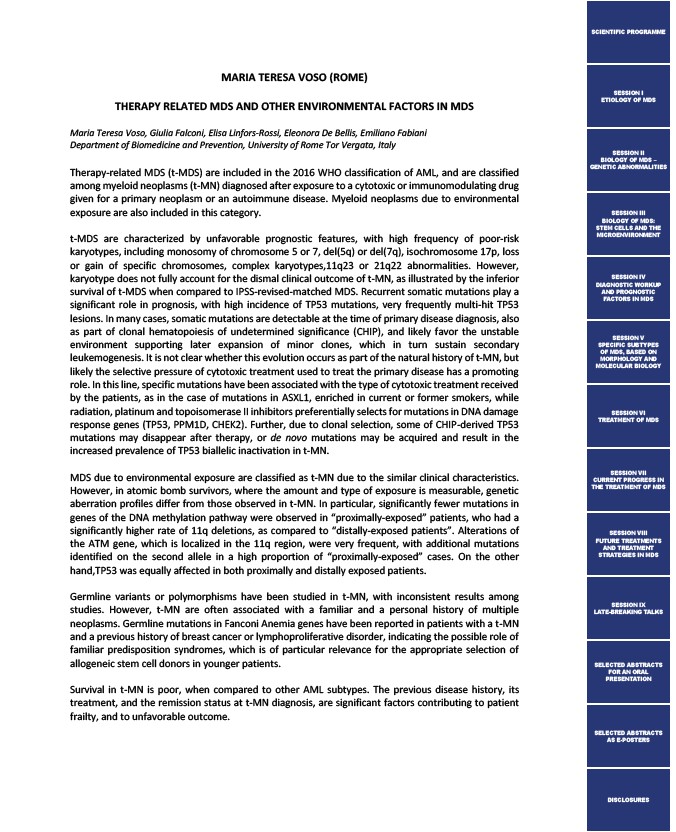
MARIA TERESA VOSO (ROME)
THERAPY RELATED MDS AND OTHER ENVIRONMENTAL FACTORS IN MDS
Maria Teresa Voso, Giulia Falconi, Elisa Linfors-Rossi, Eleonora De Bellis, Emiliano Fabiani
Department of Biomedicine and Prevention, University of Rome Tor Vergata, Italy
Therapy-related MDS (t-MDS) are included in the 2016 WHO classification of AML, and are classified
among myeloid neoplasms (t-MN) diagnosed after exposure to a cytotoxic or immunomodulating drug
given for a primary neoplasm or an autoimmune disease. Myeloid neoplasms due to environmental
exposure are also included in this category.
t-MDS are characterized by unfavorable prognostic features, with high frequency of poor-risk
karyotypes, including monosomy of chromosome 5 or 7, del(5q) or del(7q), isochromosome 17p, loss
or gain of specific chromosomes, complex karyotypes,11q23 or 21q22 abnormalities. However,
karyotype does not fully account for the dismal clinical outcome of t-MN, as illustrated by the inferior
survival of t-MDS when compared to IPSS-revised-matched MDS. Recurrent somatic mutations play a
significant role in prognosis, with high incidence of TP53 mutations, very frequently multi-hit TP53
lesions. In many cases, somatic mutations are detectable at the time of primary disease diagnosis, also
as part of clonal hematopoiesis of undetermined significance (CHIP), and likely favor the unstable
environment supporting later expansion of minor clones, which in turn sustain secondary
leukemogenesis. It is not clear whether this evolution occurs as part of the natural history of t-MN, but
likely the selective pressure of cytotoxic treatment used to treat the primary disease has a promoting
role. In this line, specific mutations have been associated with the type of cytotoxic treatment received
by the patients, as in the case of mutations in ASXL1, enriched in current or former smokers, while
radiation, platinum and topoisomerase II inhibitors preferentially selects for mutations in DNA damage
response genes (TP53, PPM1D, CHEK2). Further, due to clonal selection, some of CHIP-derived TP53
mutations may disappear after therapy, or de novo mutations may be acquired and result in the
increased prevalence of TP53 biallelic inactivation in t-MN.
MDS due to environmental exposure are classified as t-MN due to the similar clinical characteristics.
However, in atomic bomb survivors, where the amount and type of exposure is measurable, genetic
aberration profiles differ from those observed in t-MN. In particular, significantly fewer mutations in
genes of the DNA methylation pathway were observed in “proximally-exposed” patients, who had a
significantly higher rate of 11q deletions, as compared to “distally-exposed patients”. Alterations of
the ATM gene, which is localized in the 11q region, were very frequent, with additional mutations
identified on the second allele in a high proportion of “proximally-exposed” cases. On the other
hand,TP53 was equally affected in both proximally and distally exposed patients.
Germline variants or polymorphisms have been studied in t-MN, with inconsistent results among
studies. However, t-MN are often associated with a familiar and a personal history of multiple
neoplasms. Germline mutations in Fanconi Anemia genes have been reported in patients with a t-MN
and a previous history of breast cancer or lymphoproliferative disorder, indicating the possible role of
familiar predisposition syndromes, which is of particular relevance for the appropriate selection of
allogeneic stem cell donors in younger patients.
Survival in t-MN is poor, when compared to other AML subtypes. The previous disease history, its
treatment, and the remission status at t-MN diagnosis, are significant factors contributing to patient
frailty, and to unfavorable outcome.
SCIENTIFIC PROGRAMME
SESSION I
ETIOLOGY OF MDS
SESSION II
BIOLOGY OF MDS –
GENETIC ABNORMALITIES
SESSION III
BIOLOGY OF MDS:
STEM CELLS AND THE
MICROENVIRONMENT
SESSION IV
DIAGNOSTIC WORKUP
AND PROGNOSTIC
FACTORS IN MDS
SESSION V
SPECIFIC SUBTYPES
OF MDS, BASED ON
MORPHOLOGY AND
MOLECULAR BIOLOGY
SESSION VI
TREATMENT OF MDS
SESSION VII
CURRENT PROGRESS IN
THE TREATMENT OF MDS
SESSION VIII
FUTURE TREATMENTS
AND TREATMENT
STRATEGIES IN MDS
SESSION IX
LATE-BREAKING TALKS
SELECTED ABSTRACTS
FOR AN ORAL
PRESENTATION
SELECTED ABSTRACTS
AS E-POSTERS
DISCLOSURES